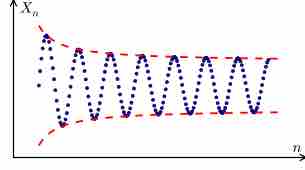Sequences
In mathematics, a sequence is an ordered list of objects. Like a set, it contains members (also called elements or terms). The number of ordered elements (possibly infinite) is called the length of the sequence. Unlike a set, order matters, and a particular term can appear multiple times at different positions in the sequence.
For example,

Sequence
Part of an infinite sequence of real numbers (in blue). This sequence is neither increasing, nor decreasing, nor convergent. It is, however, bounded within the two dashed lines.
Examples and Notation
Finite and Infinite Sequences
A more formal definition of a finite sequence with terms in a set
A sequence of a finite length n is also called an
Recursive Sequences
Many of the sequences you will encounter in a mathematics course are produced by a formula, where some operation(s) is performed on the previous member of the sequence
Arithmetic Sequences
An arithmetic (or linear) sequence is a sequence of numbers in which each new term is calculated by adding a constant value to the previous term. An example is
Another example is
In both of these examples,
Geometric Sequences
A geometric sequence is a list in which each number is generated by multiplying a constant by the previous number. An example is
Another example is
In both examples
Explicit Definitions
An explicit definition of an arithmetic sequence is one in which the
To find the explicit definition of an arithmetic sequence, you begin writing out the terms. Assume our sequence is
and so on. From this you can see the generalization that:
which is the explicit definition we were looking for.
The explicit definition of a geometric sequence is obtained in a similar way. The first term is